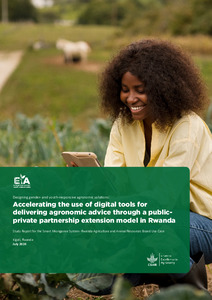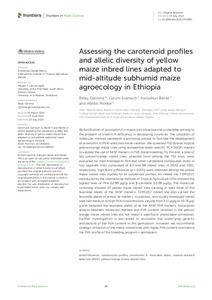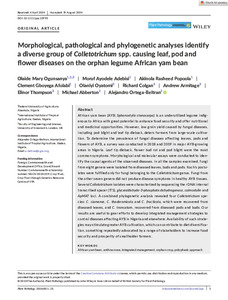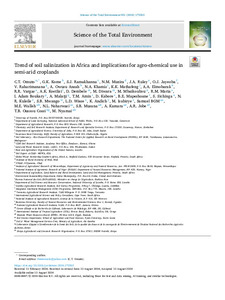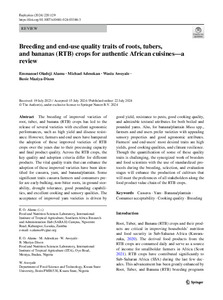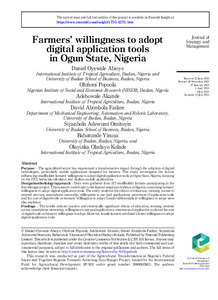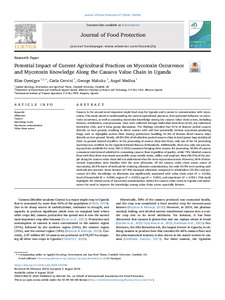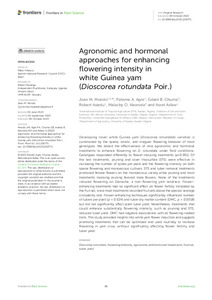Welcome to the International Institute of Tropical Agriculture Research Repository
IITA Bibliography System: Recent submissions
Now showing items 101-120 of 8091
-
Designing gender- and youth-responsive agronomic solutions: accelerating the use of digital tools for delivering agronomic advice through a public-private partnership extension model in Rwanda
(International Institute of Tropical Agriculture, 2024-07)This report is part of a study series offering insights into the potential of Excellence in Agronomy (EiA) Use Cases to adjust the agronomic solutions offered through the Minimum Viable Products (MVP) to better reach, benefit, and empower women and youths, and to transform norms that cause gender and social inequalities. These efforts are guided appropriately by the Reach-Benefit-Empower-Transform framework that highlights the importance of not only reaching women and young people, but also making ... -
Occurrence and distribution of major cassava pests and diseases in cultivated cassava varieties in western Kenya
(2024-09-15)Cassava is an important food crop in western Kenya, yet its production is challenged by pests and diseases that require routine monitoring to guide development and deployment of control strategies. Field surveys were conducted in 2022 and 2023 to determine the prevalence, incidence and severity of cassava mosaic disease (CMD) and cassava brown streak disease (CBSD), whitefly numbers and incidence of cassava green mite (CGM) in six counties of western Kenya. Details of the encountered cassava ... -
Climate-resilient aquatic food systems require transformative change to address gender and intersectional inequalities
(2024-07-16)The adverse impacts of climate change on aquatic food systems (AFS) and the people who depend on AFS for livelihood security are inequitably distributed between and within countries. People facing the highest risks and experiencing the severest impacts of climate change are those who already experience multidimensional inequalities in their lives, particularly because of their gender, class, age, indigeneity, ethnicity, caste, religion, and the physical and political conditions that can create ... -
Assessing the carotenoid profiles and allelic diversity of yellow maize inbred lines adapted to mid-altitude subhumid maize agroecology in Ethiopia
(2024-07-23)Biofortification of provitamin A in maize is an attractive and sustainable remedy to the problem of vitamin A deficiency in developing countries. The utilization of molecular markers represents a promising avenue to facilitate the development of provitamin A (PVA)-enriched maize varieties. We screened 752 diverse tropical yellow/orange maize lines using kompetitive allele-specific PCR (KASP) makers to validate the use of KASP markers in PVA maize breeding. To this end, a total of 161 yellow/orange ... -
Morphological, pathological and phylogenetic analyses identify a diverse group of Colletotrichum spp. causing leaf, pod and flower diseases on the orphan legume African yam bean
(2024-09-02)African yam bean (AYB; Sphenostylis stenocarpa) is an underutilized legume indigenous to Africa with great potential to enhance food security and offer nutritional and medicinal opportunities. However, low grain yield caused by fungal diseases, including pod blight and leaf tip dieback, deters farmers from large‐scale cultivation. To determine the prevalence of fungal diseases affecting leaves, pods and flowers of AYB, a survey was conducted in 2018 and 2019 in major AYB‐growing areas in Nigeria. ... -
Assessing the effect of provitamin a on maize field resistance to aflatoxin and fumonisin contamination
(2024-11)Vitamin A deficiency in sub-Saharan Africa is mainly being addressed through crop biofortification. Several high provitamin A (PVA) maize varieties have been released as part of these measures. However, these varieties are grown in areas where Aspergillus ear rot (AER) and Fusarium ear rot (FER) frequently occur, leading to contamination with mycotoxins, which in turn reduce the yield and grain quality. Chronic mycotoxin exposure leads to serious public health problems. Therefore, PVA maize varieties ... -
Exploring the genetic diversity and population structure of aerial yams (Dioscorea bulbifera L.) DArT-seq and agronomic traits
(2024-08-23)Dioscorea bulbifera is an edible yam specie with aerial bulbils. Assessing the genetic diversity of D. bulbifera accession for cultivation and breeding purposes is essential for it genetic improvement, especially where the crop faces minimal attention. The aims of this study was to assess the genetic diversity of Dioscorea bulbifera accessions collected from Nigeria and accessions maintained at the genebank of International Institute of Tropical Agriculture (IITA) Ibadan. Accessions were profiled ... -
Long read sequencing and assembly of wild diploid relatives and cultivars in support of banana breeding programs
(2024-09)Banana is an important fruit and staple crop, which is vital for food and income security in developing countries. A genomics initiative was undertaken as part of the Global Alliance against TR4 (Tropical Race 4 of Fusarium Wilt of Banana) Alliance, with Bayer Crop Science, International Institute of Tropical Agriculture, and University of Queensland to collectively accelerate the breeding efforts in Eastern Africa. The goal of this project is to develop genomics resources to improve banana breeding, ... -
Evaluating the dry matter content of raw yams using hyperspectral imaging spectroscopy and machine learning
(2024-11)Yams (Dioscorea spp.) are important food and commercial crops in West African countries. They contribute significantly to global food production and provide dietary energy. The quality of yam food products depends on specific internal and external parameters, such as the DMC and other biochemical traits. However, measuring these traits can be challenging, particularly when analyzing many genotypes. This study aimed to evaluate the feasibility of using near-infrared (NIR) hyperspectral imaging ... -
Too fast or too slow: the speed and persistence of adoption of conservation agriculture in southern Africa
(2024-11)Conservation agriculture (CA) represents a paradigm shift towards more sustainable and climate-smart intensification of smallholder farming systems in southern Africa. This can only be achieved with reasonably fast, widespread, and sustained adoption of CA. However, many farmers are slow to adopt CA and when they do, they often do not continue using it and eventually dis-adopt. We combine duration models and quantile regression models to study how long farmers take to adopt conservation agriculture ... -
Conservation agriculture practices: adaptation and yield
(2024)Conservation agriculture (CA) has been promoted in sub-Saharan Africa (SSA) to increase crop productivity and for climate change adaptation. CA is the simultaneous application of the three principles: no-till, mulch cover, and crop diversification. The potential benefits are largely linked to moisture conservation of crop residues, reduced run-off and erosion, increased infiltration, and reduced evaporative losses. This study uses a review of recent literature in SSA under rain-fed conditions to ... -
Trend of soil salinization in Africa and implications for agro-chemical use in semi-arid croplands
(2024-11-15)Soil salinization is a gradual degradation process that begins as a minor problem and grows to become a significant economic loss if no control action is taken. It progressively alters the soil environment which eventually negatively affects plants and organism that were not originally adapted for saline conditions. Soil salinization arises from diverse sources such as side-effects of long-term use of agro-chemicals, saline parent rocks, periodic inundation of soil with saline water, etc. In Africa, ... -
Breeding and end‑use quality traits of roots, tubers, and bananas (RTB) crops for authentic African cuisines—a review
(2024-07-22)The breeding of improved varieties of root, tuber, and banana (RTB) crops has led to the release of several varieties with excellent agronomic performances, such as high yield and disease resistance. However, farmers and end users have hampered the adoption of these improved varieties of RTB crops over the years due to their processing capacity and final product quality. Across the RTB crops, the key quality and adoption criteria differ for different products. The vital quality traits that can ... -
Unanswered questions and unquestioned answers: the challenges of crop residue retention and weed control in conservation agriculture systems of southern Africa
(2024-02-22)Production and utilization of crop residues as mulch and effective weed management are two central elements in the successful implementation of Conservation Agriculture (CA) systems in southern Africa. Yet, the challenges of crop residue availability for mulch or the difficulties in managing weed proliferation in CA systems are bigger than a micro-level focus on weeds and crop residues themselves. The bottlenecks are symptoms of broader systemic complications that cannot be resolved without ... -
Genome-wide association studies reveals new candidate genes associated with resistance to Striga gesneroides in Cowpea [Vigna unguiculata (L.) Walp.] accessions from sub-Saharan Africa
(2024-09)Parasitic plant Striga gesneroides reduces cowpea productivity in sub-Saharan Africa, leading to substantial yield losses. This weed is the major reason for land abandonment by many farmers. While various methods have been proposed for managing Striga invasion and parasitism, host-plant resistance remains the most effective and affordable option for small-scale farmers in the sub-region. This study aims to expedite the improvement of Striga resistance breeding through marker-assisted selection by ... -
Farmers’ willingness to adopt digital application tools in Ogun State, Nigeria
(2024-09-03)Purpose The agricultural sector has experienced a transformative impact through the adoption of digital technologies, particularly mobile applications designed for farmers. This study investigates the factors influencing smallholder farmers' willingness to adopt digital application tools in Ogun State, Nigeria, focusing on the IITA herbicide calculator and Akilimo mobile applications. Design/methodology/approach Data were gathered from 572 smallholder farmers participating in the Zero Hunger ... -
Potential impact of current agricultural practices on mycotoxin occurrence and mycotoxin knowledge along the cassava value chain in Uganda
(2024-08-06)Cassava is the second most important staple food crop for Uganda and is prone to contamination with mycotoxins. This study aimed at understanding the current agricultural practices, their potential influence on mycotoxin occurrence, as well as assessing mycotoxin knowledge among key cassava value chain actors, including farmers, wholesalers, and processors. Data were collected through individual interviews (210), key informant interviews (34), and 4 focus group discussions. The findings revealed ... -
Performances of plantlets from selected cassava (Manihot esculenta Crantz) genotypes under Semi-Autotrophic Hydroponics (SAH) using different substrates
(2023-01)The cassava seed system faces challenges due to limited seed stock caused by a slow propagation rate and a lengthy growth period. Conventional methods lacking phytosanitary guarantees further compound these issues. To address these limitations, the Semi-Autotrophic Hydroponics (SAH) technology was adopted for the rapid mass propagation of healthy, disease-free cassava plants. This research aimed to evaluate the performance of cassava planting materials using different substrates for stem-cutting ... -
Agronomic and hormonal approaches for enhancing flowering intensity in white Guinea yam (Dioscorea rotundata Poir.)
(2023-10-09)Developing novel white Guinea yam (Dioscorea rotundata) varieties is constrained by the sparse, erratic, and irregular flowering behavior of most genotypes. We tested the effectiveness of nine agronomic and hormonal treatments to enhance flowering on D. rotundata under field conditions. Genotypes responded differently to flower-inducing treatments (p<0.001). Of the test treatments, pruning and silver thiosulfate (STS) were effective in increasing the number of spikes per plant and the flowering ... -
Determination of abundance and symbiotic effectiveness of native rhizobia nodulating soybean and other legumes in Rwanda
(2024-04)Rhizobia diversity in the rhizosphere is one of the key promoters of biological nitrogen fixation between host legumes and microsymbionts, although related complex interaction may depend on various factors. This research was intended to assess the abundance of indigenous rhizobia isolates under various soil conditions, as well as their effectiveness to nodulate legumes such as soybeans. Factors such as soil properties and legume species influence the volume and symbiotic effectiveness of native ...

